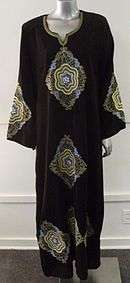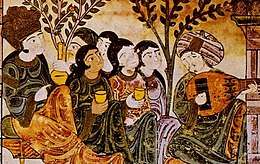Abaya
The abaya "cloak" (colloquially and more commonly, Arabic: عباية ʿabāyah , especially in Literary Arabic: عباءة ʿabāʾah ; plural عبايات ʿabāyāt , عباءات ʿabāʾāt ), sometimes also called an aba, is a simple, loose over-garment, essentially a robe-like dress, worn by some women in parts of the Muslim world including North East Africa, Somalia, Morocco, and the Arabian Peninsula.[1] Traditional abayat are black and may be either a large square of fabric draped from the shoulders or head or a long kaftan. The abaya covers the whole body except the head, feet, and hands. It can be worn with the niqāb, a face veil covering all but the eyes. Some women also wear long black gloves, so their hands are covered as well. It is common that the abayat is worn to special occasions, such as Mosque visits and Islamic Holiday celebrations for Eid al-Fitr and Eid al-Adha.

 |
| Part of a series on |
| Islamic female dress |
|---|
| Types |
| Practice and law by country |
| Concepts |
| Other |
The Indonesian traditional dress kebaya gets its name from the abaya.
Rationale
The rationale for the abaya is often attributed to the Quranic quote, "O Prophet, tell your wives and daughters, and the believing women, to cover themselves with a loose garment. They will thus be recognised and no harm will come to them" (Qur'an 33:59,[2] translated by Ahmed Ali). This quotation is often given as the argument for wearing the abaya.
The abaya is most common in countries with large Muslim populations. Some denominations of Islam consider the entire female body, except for the face and hands, awrah – that which should be concealed in public from males unrelated by blood or marriage.
Countries
Outside some Arab states such as Saudi Arabia, the abaya is not widely worn by Muslim women. It is rare in countries like Indonesia, India and Pakistan. Abaya also refers to different garments in different countries. In Arab states of the Persian Gulf, they tend to be black in color. Turkish abayat, on the other hand, tend to be colorful.
Saudi Arabia
In Saudi Arabia, women are required to cover in public.[3] However, in March 2018, the Crown Prince Mohammad bin Salman claimed that women could choose what to wear in public, provided it met certain standards, when he stated, "The decision is entirely left for women to decide what type of decent and respectful attire she chooses to wear".[4][5]
Styles
Abayat are known by various names but serve the same purpose, which is to cover. Contemporary models are usually caftans, cut from light, flowing fabrics like crepe, georgette, and chiffon. Other known styles are front open and front closed abaya. Styles differ from region to region: some abayat have embroidery on black fabric while others are brightly coloured and have different forms of artwork across them.
See also
- Islam and clothing
- Types of hijab
References
- Yarwood, Doreen (1978). The Encyclopedia of World Costume. New York: Bonanza Books. p. 9. ISBN 0-517-61943-1.
- "Center for Muslim-Jewish Engagement". Usc.edu. Archived from the original on 2011-08-23. Retrieved 2012-08-22.
- Sanders, Eli. Interpreting veils: Meanings have changed with politics, history. Archived December 3, 2009, at the Wayback Machine The Seattle Times. 27 May 2003. Web. 30 Oct. 2009.
- Kalin, S. Saudi women should be able to choose whether to wear head cover or black abaya in public, says Crown Prince. Retrieved 19.03.2018
- Editorial, Reuters. "Saudi women should have choice whether to wear abaya robe: crown..." U.S. Retrieved 2018-03-22.
External links
- Kaur-Jones, Priya. "Reinventing the Saudi abaya." BBC. 12 May 2011.
- History of Abaya. "History of Abaya."
